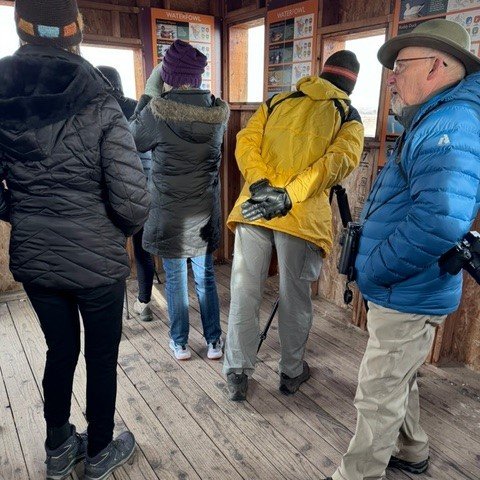The Wonder of Snow Geese
By Bhavana Padiyath, Golden Eagle Guest Blogger
Every year around mid-March, Fort Boise Wildlife Management Area (WMA) in Idaho becomes a stunning stopover for a massive migration of Snow Geese. These snow-white birds, numbering up to 50,000, take a break in the wetlands and farm land near Parma, ID where the Boise and Snake rivers converge. They then continue their journey north to their nesting grounds in the Arctic tundra.
Native to North America, the Snow Goose (Anser caerulescens) with its dominant white plumage and graceful flight, embodies the spirit of migration. Twice a year, these birds embark on a remarkable journey, following ancient flyways that connect their Arctic breeding grounds to their wintering grounds that range from British Columbia to Mexico.
Sorting Out the Geese
Unlike most other birds, Snow Geese come in two sizes. The Greater Snow Goose is 31” long and the Lesser Snow Goose is 28” long. The Greater Snow Goose is the most common, with a population exceeding five million. The Lesser Snow Goose has a population of around one and a half million. Both of these geese come in a light morph and a much less common dark morph (aka Blue Goose). Look closely at the photo on the right and you’ll see a dark morph Snow Goose in the center. The closely-related Ross’s Goose loves to hang with the Snow Geese. It’s smaller and easily distinguished by its black neck patch and shorter bill.
Snow Geese at Fort Boise WMA by Jim James
The Snow Goose and Ross’s Goose share many characteristics. They primarily feed on grasses, sedges, and other aquatic plants. Their breeding plumage is a stunning snow white, while their non-breeding plumage can have varying degrees of barring or mottling with brown and gray.
Snow Geese like many other white and light gray birds (Whooping Crane, Wood Stork, Northern Gannet, American White Pelican, White Ibis, Snow Bunting, albatross, gulls etc.) have black wingtips. Primary feathers are the longest feathers, extending out the farthest from the body, controlling flight precision and are the most prone to abrasion. Melanin - the pigment that darkens the feather tip - makes the tips stronger than the lighter areas.
Source: https://www.audubon.org/news/ask-kenn-kaufman-why-do-so-many-white-birds-have-black-wingtips
With Spring Comes Action
Spring marks a dramatic shift for Snow Geese. As the world awakens from winter's slumber, these birds embark on a spectacular northward trek, painting the skies white along the way.
The sight and cacophony of thousands of geese filling the sky is a dazzling display for visitors and heralds spring for Treasure Valley locals. Imagine a vast white cloud, tens of thousands strong, flying in a V-formation, their honking calls echoing across the land and water. I attended a Golden Eagle Audubon Society trip to Fort Boise WMA on March 9 and witnessed exactly that. The WMA has a viewing platform perfectly located to enjoy this phenomenon.
Snow Geese at Fort Boise WMA by Jim James The viewing platform at Fort Boise WMA by Bhavana Padiyath
This is also the time of year to spot the northern migration of the Greater White-fronted Goose and Sandhill Crane in the marshes, ponds and fields around here. We also witnessed more than a dozen other species at Fort Boise WMA and various sites around Parma including Martin’s Landing. We are grateful to Jim James for leading and Linda Wentz for assisting.
The Journey North
In spring, as the Arctic tundra thaws and the daylight hours lengthen, hundreds of thousands of snow geese head to their breeding grounds north of the timberline in Greenland, Canada, Alaska, and the northeastern tip of Siberia. Stopover sites like Fort Boise WMA in Idaho provide crucial rest and feeding opportunities to replenish energy reserves for the long journey. Unpredictable weather, food scarcity, and predators like falcons and eagles pose challenges along the way.
In the Artic, peaceful landscapes transform into a flurry of activity as courtship rituals unfold. Nests are built near water sources and clutch sizes typically range from 3 to 5 eggs. After a roughly four-week incubation period, precocial goslings emerge, able to leave the nest and feed themselves within within a day or two.
Arctic foxes and jaegers pose a constant threat to eggs and goslings. Harsh weather conditions can also impact survival rates. Despite the challenges, Snow Goose populations increased dramatically in the 20th century.
The Journey South
By late summer, as the Arctic days shorten and temperatures begin to plummet, Snow Geese prepare for their return journey south. The young, now strong and capable fliers, join the experienced adults as they once again gather in large flocks. Their southward migration follows similar routes as their northbound trip, taking advantage of established food sources and resting areas along the way.
Reaching their wintering grounds in the southern United States and Mexico provides the snow geese with a much-needed respite. The warmer climate provides an abundance of food sources, primarily in the form of agricultural crops like corn and rice. Here, they rest, replenish their energy reserves, and prepare for the next breeding season. Some Snow Geese winter at Fort Boise WMA.
Snow Geese can be voracious grazers, and their large numbers can damage sensitive wetlands and agricultural fields. Conservation efforts are underway to address these challenges.
The Snow Goose migration is a testament to the resilience and adaptability of these remarkable birds. Their journey is a reminder of the interconnectedness of our planet and the delicate balance of ecosystems.
“One brisk morning I stood in a field chilled frosty by autumn’s touch. Suddenly, the hordes of geese that surrounded me lifted off into the sky in a thunderous roar of nature on a grand mission. Standing stunned and awed in a field now fallen silent, it dawned on me that something is most powerful when it believes in its mission and rises without hesitation to achieve it.”
Snow Geese on the wing by Bhavana Padiyath


